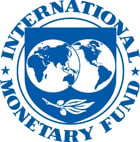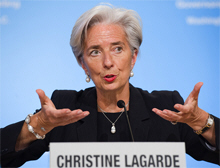
Typical street scene in Santa Ana, El Salvador. (Photo: iStock)
IMF Survey: G-20 Moves Forward to Tackle Global Imbalances
April 16, 2011
- G-20 agrees guidelines to measure possibly destabilizing global imbalances
- Aim to reduce risks of crisis in global economy
- Enhanced IMF role in assessing countries’ performance against guidelines
Finance ministers and central bank governors of the Group of Twenty (G-20) industrialized and emerging market economies, seeking to make the world less prone to crisis, moved a step forward by agreeing a set of guidelines to measure potentially destabilizing imbalances in the global economy.

French Finance Minister, G-20 Chair Christine Lagarde addresses news conference after Washington meeting (photo: Stephen Jaffe/IMF)
G-20 FINANCE MINISTERS MEETING
The agreement—reached in Washington DC during the IMF-World Bank Spring Meetings—provides a concrete basis for G-20 countries to assess each others’ economic policies, with a view to address large imbalances and support the G-20’s growth objectives. The process will draw on independent analysis by the International Monetary Fund (IMF).
“One of the major objectives of today’s meeting was to make sure we could agree on continuing the process and agree on the indicative guidelines, and we did,” said Christine Lagarde, G-20 Chair and French Finance Minister told reporters on April 15.
The guidelines are part of a broader work agenda prompted by the enormous human and financial costs of the global economic crisis, which triggered a worldwide recession. The G-20’s Framework for Strong, Sustainable, and Balanced Growth aims to ensure a lasting recovery and strong and sustainable growth over the medium term.
“Agreeing on the indicative guidelines was a major step in the direction of establishing the right policies,” added Lagarde. She also acknowledged the “excellent work by the IMF, regional development banks and other international financial institutions.”
Objective assessment
Yesterday’s agreement builds on the much debated set of indicators intended to measure imbalances in the global economy that were agreed in February at the G-20 ministerial meeting in Paris. Those indicators comprise:
• public debt and fiscal deficits;
• private saving rate and private debt; and
• the external balance reflecting the trade balance and net investment income flows and transfers, “taking due consideration of exchange rate, fiscal, monetary and other policies.”
The G-20 has now established indicative guidelines, or a process, by which it will assess country performance against each of these indicators, in the context of their Mutual Assessment Process (MAP) and with the assistance of the IMF.
“Each of the three indicators that we had agreed in Paris is going to be reviewed for each country in the light of an economic model and three statistical models,” explained Lagarde. According to the G-20’s new guidelines, each country’s performance will be compared against four reference points for each indicator based on a combination of structural and statistical approaches to take into country specific circumstances and factors.
The mechanical and objective nature of the assessment process was a point stressed by both Lagarde and French central bank governor Christian Noyer. The technical nature of the assessment leaves little room for subjective judgment or biased views.
”When you see that variations are relatively strong … it’s not to say these countries have a problem they have to correct. We say objectively there have been changes on the amount of deficit, debt, whatever [indicator] it is—there may be good explanations,” said Noyer.
While all G-20 countries will be evaluated on the basis of these guidelines, they will apply more stringently to the seven biggest G-20 economies.
Lagarde explained that “the guidelines operate a little bit like a net … and the net is a little bit tighter for those countries that are considered of systemic importance because they represent more than 5 percent of the GDP of the G-20.”
‘MAP Plus’
Agreement on the guidelines means that the G-20 has completed step 1 of the framework for growth process. From here, Lagarde said, “we’re going to move into step 2, which will help us make actual recommendations to the Leaders and Heads of State in October.”
Until now, the IMF’s role has been to provide technical support in developing the indicative guidelines and analysis for the MAP to evaluate how G-20 countries’ policies fit together—and whether, collectively, they can achieve the G-20’s goals—including through alternative scenarios.
Moving into the second phase of this process, Lagarde said, “the IMF is now going to do, what I would call a ‘MAP plus’.” The IMF’s assessment of progress toward external sustainability will focus specifically on those countries identified as having imbalances based on the indicative guidelines. In doing so, the IMF will work with other international organizations.
The G-20 will then discuss the IMF’s analysis of imbalances, endorse the recommendations, and see if “the policies in place are already working to correct that or if additional policy recommendations would be useful to be discussed among ourselves,” said Noyer. It will then be for leaders and heads of state to decide.
Progress on all fronts
French representatives were pleased with the progress in the G-20’s efforts to address global imbalances. “It was a happy G-20; very constructive, very pragmatic. We made progress on all topics of the agenda,” Noyer said.
In relation to the international monetary system, the G-20 focused on: volatility of capital flows, liquidity management, the role played by the IMF’s special drawing rights, the multiplicity of reserve currencies, and reserve accumulation.
The G-20 also signaled a move away from an all-or-nothing approach to capital controls. They are working toward a “mechanism” for assessing preferred options that could be used to reduce the negative impacts of abrupt capital flows. “But we have more work to do, with the help of the IMF,” said Noyer.
The IMF was also asked to contribute to the macroeconomic impact study for work by the Financial Stability Board and others on systemically important financial institutions.
Two other issues discussed were climate change financing options—where the group called on the World Bank to work with the IMF and regional development banks—and the inflation and social impacts of high and volatile commodity prices.


